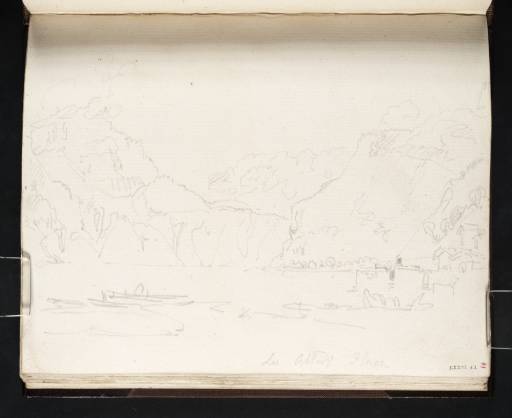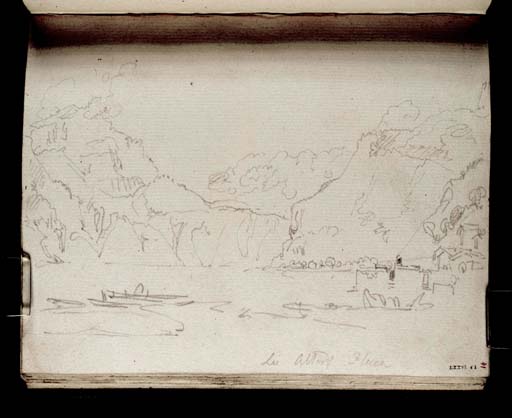Joseph Mallord William Turner Lake Lucerne from Fluelen 1802
Image 1 of 2
Joseph Mallord William Turner,
Lake Lucerne from Fluelen
1802
Joseph Mallord William Turner 1775–1851
Folio 41 Recto:
Lake Lucerne from Fluelen 1802
D04698
Turner Bequest LXXVI 41
Turner Bequest LXXVI 41
Pencil on white laid paper, 156 x 201 mm
Inscribed by Turner in pencil ‘Lu Altorf. Fluelen’ lower right of centre
Inscribed by John Ruskin in red ink ‘41’ bottom right, descending vertically
Stamped in black ‘LXXVI 41’ bottom right
Inscribed by Turner in pencil ‘Lu Altorf. Fluelen’ lower right of centre
Inscribed by John Ruskin in red ink ‘41’ bottom right, descending vertically
Stamped in black ‘LXXVI 41’ bottom right
Accepted by the nation as part of the Turner Bequest 1856
Exhibition history
1879
Oxford Loan Collection, University Galleries, Oxford, 1879 until at least 1909 (166–164a, as ‘Fluelen. Sketch for Farnley picture’).
References
1909
A.J. Finberg, A Complete Inventory of the Drawings of the Turner Bequest, London 1909, vol.I, p.205, LXXVI 41, as ‘Altorf. Fluelen’.
1964
Kenneth Clark, Elizabeth Davidson and John Gage, Ruskin and his Circle, exhibition catalogue, Arts Council Gallery, London 1964, p.31 under cat. no.104.
1976
John Russell and Andrew Wilton, Turner in Switzerland, Zurich 1976, p.135.
1979
Andrew Wilton, The Life and Work of J.M.W. Turner, Fribourg 1979, p.342.
1980
David Hill, Stanley Warburton, Mary Tussey and others, Turner in Yorkshire, exhibition catalogue, York City Art Gallery, York 1980, p.56 under cat.no.82.
2007
James Hamilton, ‘The Ullens Collection: an Appreciation’, in Henry Wemyss and others, Important Turner Watercolours from the Guy and Myriam Ullens Collection, London (Sotheby’s) 2007, p.13 reproduced in colour.
2007
William Hauptman, ‘Turner at Lake Lucerne’, in Wemyss 2007, p.60.
This sketch was taken from the landing place at Fluelen, at the eastern extremity of Lake Lucerne, looking back up the lake over the waters over which Turner had just sailed from Lucerne itself at its western tip, and towards William Tell’s chapel. The peaks of the Bauenstöcke and the Seelisberg rise above the lake on the left, the foot of the Axenberg on the right. Turner was on his way south-eastwards towards the River Reuss, the city of Altdorf (noted in his inscription) and the St Gotthard Pass. Another view from the landing place may be on folio 42 of this sketchbook (D04699). For Tell’s Chapel, see especially folios 70 and 71 (D04730, D04731). William Hauptman records that the journey from Lucerne, a distance of about twenty-five miles, was then only possible by boat; sailing boats with oarsmen usually covered it in about six hours. Rowing boats are visible to the left of Turner’s sketch.
As first noticed when it was exhibited at Oxford, this sketch served as the basis for the watercolour Lake of Lucerne, from the Landing Place at Fluelen, Looking Towards Bauen and Tell’s Chapel, Switzerland exhibited at the Royal Academy in 1815 (but perhaps made earlier) and acquired by Walter Fawkes (recently on the London art market).1 The watercolour was conceived as a companion to The Battle of Fort Rock, Val d’Aouste, Piedmont, 1796 (Tate D04900; Turner Bequest LXXX G) and is usually thought to be a contrasting representation of peace. However, the presence in it of a girl who appears to be weeping and a distraught elderly woman whose baggage has been overturned suggest underlying tensions. These too might recall recent disturbances; in June 1799 the Austrians had joined the local Swiss to eject the occupying French but the French had returned across the lake, forcing the Austrians to retreat, while a Russian army approaching from the St Gotthard was also driven back. See folio 66 of this sketchbook (D04726) for another possible alternative subject for a companion work, realised only in an unfinished watercolour (Tate D04897; Turner Bequest LXXX D). Turner also added military narrative to his reworkings, for Walter Fawkes and for the Liber Studiorum, of his view of Lake Thun from the landing place at Neuhaus on folio 60 (D04717).
The present sketch is not marked with the initial ‘F’ usually applied to subjects reserved for Fawkes. See note to folio 43 (D04700), which is marked up in this way but perhaps in error as no finished watercolour of the subject (the Wellhorn and Rosenlaui Glacier) is known to have been made.
Verso:
Blank
Inscribed by John Ruskin in red ink ‘594’ top left, descending vertically
David Blayney Brown
October 2009
How to cite
David Blayney Brown, ‘Lake Lucerne from Fluelen 1802 by Joseph Mallord William Turner’, catalogue entry, October 2009, in David Blayney Brown (ed.), J.M.W. Turner: Sketchbooks, Drawings and Watercolours, Tate Research Publication, December 2012, https://www


